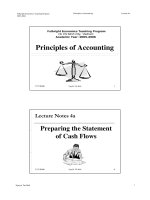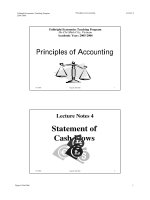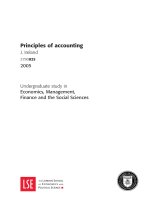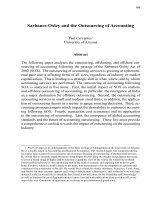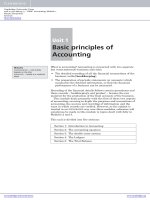Hansie Hendricks Excerpt: Basic principles of Accounting docx
Bạn đang xem bản rút gọn của tài liệu. Xem và tải ngay bản đầy đủ của tài liệu tại đây (491.05 KB, 10 trang )
Basic principles of
Accounting
What is accounting? Accounting is concerned with two separate
but
COMPLEMENTARY business activities:
• The detailed recording of all the financial transactions of the
business (called bookkeeping).
• The preparation of periodic statements (or accounts) which
summarise the detailed information, so that the financial
performance of a business can be measured.
Recording of the financial details follows certain procedures and
these records – bookkeeping’s end product – become the raw
material for the production of the final accounts of the business.
This module deals primarily with the first of these two aspects
of accounting, covering in depth the purposes and conventions of
accounting, the sources and recording of information and the
ways in which records are verified. However, as the subject is
treated in an
INTEGRATED way over three modules, reference will
sometimes be made in this module to topics dealt with fully in
Modules 2 and 3.
This unit is divided into five sections:
Section 1: Introduction to Accounting
Section 2: The accounting equation
Section 3: The double entry system
Section 4: The Ledgers
Section 5: The Trial Balance
Unit 1Unit 1
Glossary
COMPLEMENTARY – each activity
depends on the other
INTEGRATED – treated as a combined
whole
© Cambridge University Press www.cambridge.org
Cambridge University Press
978-0-521-68074-5 - NSSC Accounting Module 1
Hansie Hendricks
Excerpt
More information
2
NSSC Accounting
Section 1 Introduction to Accounting
By the end of this section, you should be able to:
• explain the meaning of the term “accounting”
• explain the objectives of Accounting
• explain the importance of Accounting information to various users
• identify the branches of Accounting
• explain the principles of business entity and money measurement and
illustrate with examples
• discuss ethics in the job, the combating of fraud, and financial risk
management
• explain the application of computers in accounting records and their
usefulness in business situations
• explain the advantages of a computerised system vs. a manual system of
Accounting
• explain the application and advantages of computers as a tool for
communication technology
The term Accounting
Accounting is termed as the analysis, classification and
recording of financial transactions, and the ascertainment of
how such transactions affect the performance and financial
position of a business.
Accounting is therefore concerned with:
• recording of data
• classification and summary of data
• communicating what has been learned from the data.
Objectives of Accounting
The following are some of the objectives that you should achieve
while studying this subject:
• use the accounting rules or concepts to analyse case studies
and real business events
• interpret and evaluate accounting statements, systems and
reports
• providing a means of developing a critical and analytical
approach to quantative problems
• apply numeric skills required for Accounting
• use Accounting to assist in decisionmaking and
• describe the impact of computers on Accounting.
© Cambridge University Press www.cambridge.org
Cambridge University Press
978-0-521-68074-5 - NSSC Accounting Module 1
Hansie Hendricks
Excerpt
More information
3
Module 1 Unit 1
Recording financial information
Who needs financial information?
The day-to-day records of financial transactions are a vital part of
running any kind of business. Of course individuals also have
some financial records. Payslips show wages received like the
Kumalo family in the picture below, bills show a person’s
spending, and regular statements tell customers how much
they have in the bank. So not only can the Kumalo's gain a clear
picture of their present financial position, they can also use such
information to plan for the future – to see if they can afford a
family vacation or, perhaps next year, a new car.
Financial information for businesses
Businesses operate in a similar way to the Kumalo's, but with
more formal systems for recording and using their financial
information. Even in a small business the owner could not
remember the details of every transaction, so some form of record
is needed.
The development of monetary systems (gradually replacing
direct exchange, known as barter) allowed the results of trade
and commerce to be measured more exactly, but
FORMAL
recording methods followed only slowly. By the end of the
fifteenth century, however,
DOUBLE ENTRY BOOKKEEPING had
become an established method of recording and remains the
basis of today’s accounting systems.
The nature of the financial records kept will depend on the
type of business being considered. For example, the owner of a
retail shop will need details of daily sales receipts, assistants’
wages and other expenses such as rent and insurance.
A
manufacturing business, on the other hand, will include records of
its raw material purchases, finished product sales, equipment and
machinery and a detailed analysis of its expenses
.
Glossary
FORMAL – following an agreed
method
DOUBLE ENTRY BOOKKEEPING –
a system of recording financial
information which recognises that
there are two aspects to every
business transaction
© Cambridge University Press www.cambridge.org
Cambridge University Press
978-0-521-68074-5 - NSSC Accounting Module 1
Hansie Hendricks
Excerpt
More information
But remember: Whatever the size and type of business, the
principles of the system are the same:
Importance of Accounting to various information
users
Information needs to be communicated to interested parties. No
business can operate in isolation. It needs other people and
businesses to operate. Let us look at each of the external and
internal users of the data and how the books of the business will
be important to them.
Internal users
• Owner: The owner obviously needs to see whether his/her
investment has made a profit or a loss.
4
NSSC Accounting
Recording the day-to-day
financial transactions
Enabling preparation of
periodic financial summaries
and interpretation of it
BOOKKEEPING
ACCOUNTING
© Cambridge University Press www.cambridge.org
Cambridge University Press
978-0-521-68074-5 - NSSC Accounting Module 1
Hansie Hendricks
Excerpt
More information
5
Module 1 Unit 1
• Employees: As the employees are working for the business, they
have a direct interest in the financial affairs of the business.
External users
• Banks and other financial institutions: They will be
interested in whether the business will be able to repay loans, or
whether its financial position is sound when loans are requested.
• Potential investors/Prospective buyers of the business:
They want to see whether their investment will be worthwhile
and will also be interested in the progress the business has made,
or whether the business is making a profit.
• The government (Receiver of Revenue): The government will
need bank statements in order to calculate the taxes that the
business needs to pay, namely VAT and tax on profits.
• Customers and suppliers: They want to ensure that a business
is solvent prior to entering a trading relationship. This includes
actual and potential customers and suppliers.
• The local community: They may be concerned about the effects
of redundancy, closing down of factories, etc.
• Business competitors: They measure their own performance
against that of their rivals.
• Economic analysts: They attempt to establish trends by an
analysis of the results of particular businesses.
• Members of the general public: They may require information
relating to environmental, ecological or other attitudes revealed
in annual company reports.
• Future partners: They want to see whether their investment
will be worthwhile and will also be interested in the progress the
business has made, or whether the business is making a profit.
Using financial information – the key questions
It is essential to know two things about a business
1 Is it making a
PROFIT?
2 What are its
ASSETS, and are they enough to meet its
LIABILITIES ?
In any business, financial records are the main source of
information providing answers to these key questions.
The profit (or loss) of the business is measured over a certain
time period and is shown in the Trading and Profit and Loss
accounts.
The summary of the business’ financial position on a certain date
is contained in the Balance Sheet.
Glossary
PROFIT – sales revenue less expenses
(running costs) over a given time
period
ASSETS – any item of property a
business owns or is owed
LIABILITIES – what a business owes to
others
© Cambridge University Press www.cambridge.org
Cambridge University Press
978-0-521-68074-5 - NSSC Accounting Module 1
Hansie Hendricks
Excerpt
More information
6
NSSC Accounting
Branches of Accounting
The subject Accounting covers a very broad range of relevant
and related topics. It is divided into the following three
branches:
Cost and Management Accounting
That part of Accounting that has to do with the provision of
information to interested parties inside the business, especially
to managers, to help them with decisionmaking, planning,
management and control, is called cost and management
accounting.
Financial Accounting
Financial Accounting is that part of Accounting that has to do
with the provision of information to interested parties outside
the business. We know that parties like prospective buyers, the
Receiver of Revenue, banks, future partners and investors will
need information that will be provided by the financial
accountants.
Auditing
Auditing is that part of Accounting that determines whether
recorded information is a true reflection of the business
transactions that took place during an accounting period.
Auditing is done in two ways. It can be done internally, that is
when the business itself does it, or externally – when the
business contracts an outside company to do it. Most companies
make use of both methods.
The business entity principle
The business entity principle distinguishes between the
accounting aspects of a business and those of the owner(s),
which are regarded as quite separate from the business. That
means that the business’ financial records will always be treated
separately from the owners’ records – thus a sole trader’s private
bank account is kept completely separate from his or her
business bank account.
Money measurement
Only that information which can be expressed in terms of money
is recorded in accounting statements. The many other factors
that affect a business’ performance, but which cannot be
measured or expressed in monetary terms, are ignored.
© Cambridge University Press www.cambridge.org
Cambridge University Press
978-0-521-68074-5 - NSSC Accounting Module 1
Hansie Hendricks
Excerpt
More information
Ethics in the job, combating fraud and financial risk
management
Ethics
The word “ethics” refers to a set of moral principles or values that
are embraced by a certain community. The business community,
as part of the total community, also abides by certain written and
unwritten laws. Some of these laws – or rather norms and values
that can be taught (not inherited) – are:
• honesty
• self-control
• trustworthiness
• concern for others
• keeping promises
• respect for legitimate authority
• fairness
• civility
• discipline
• morality
• accountability
• integrity.
The purpose of ethics in business is to direct businessmen and
women to abide by a code of conduct that facilitates and
encourages public confidence in their products and services.
Professional accounting organisations recognise the
accounting profession’s responsibility to provide ethical
guidelines to its members.
A code of ethics is a crucial element in the forming of a
professional person.
Ethical guidelines are there to support the decisionmaking
process in situations that involve ethical questions.
When social values deteriorate, it becomes increasingly
difficult to maintain high ethical standards in accounting and
business.
Businesses need to know that the profit motive, generally
accepted knowledge and recognised standards of achievement
are not the only driving forces towards success, but that
business also has a moral and social obligation towards the
community from within which it operates.
Ethics are essential for the efficiency of an organisation.
People need to know that what they are doing is socially
meaningful and worthwhile. Ethics are also essential for
interpersonal relationships, trustworthiness and honesty.
7
Module 1 Unit 1
© Cambridge University Press www.cambridge.org
Cambridge University Press
978-0-521-68074-5 - NSSC Accounting Module 1
Hansie Hendricks
Excerpt
More information
Combating fraud
Fraud is at present one of the major causes of business failure. It
involves deliberate deception. Employees, managers, directors
and international crime syndicates are all potential white-collar
criminals.
Fraud is defined as “unlawful and intentional
misrepresentation which causes actual prejudice, or which is
potentially prejudicial to another.”
Fraud comprises the following elements:
Unlawfulness – The action must be seen to be wrong in the
eyes of the law, and of society.
Misrepresentation – A false statement made by one person to
another. The misrepresentation may take the form of word,
words and conduct, or just conduct. A misrepresentation may
also be a failure to disclose certain information in circumstances
where there is a duty to do so.
Intent – The person making the misrepresentation must have
intended or foreseen that the victim would be deceived.
Prejudice – The victim would have suffered prejudice by reason
of altering his position to his detriment after relying upon the
misrepresentation. Potential prejudice is also sufficient if it is
reasonably possible that the victim, relying on the
misrepresentation, would have suffered harm.
Fraud is a punishable crime.
Areas where fraud can occur in a business:
• Asset misappropriation
– cash/inventory supplies/assets can be stolen
– misuse of fixed assets
• Fraudulent financial statements
• Cheque fraud
• Computer crime
Fraud can be combated by means of the following:
• good staff development programmes
• sound mutual inter- and intra-personal relationships between
employers and employees
• regular stocktaking
• internal audit
• external audit
• anti-corruption laws
8
NSSC Accounting
© Cambridge University Press www.cambridge.org
Cambridge University Press
978-0-521-68074-5 - NSSC Accounting Module 1
Hansie Hendricks
Excerpt
More information
9
Module 1 Unit 1
• solid presentation techniques and procedures
• appropriate reaction planning
Fraud prevention: A four-step approach
Step 1: Screen out fraudsters before hiring them
Step 2: Reduce opportunities for fraud
Step 3: Create an “anti-fraud” environment
Step 4: Prosecute all fraudsters
Financial Risk Management
The main aim of any business is to make profit. In order to
achieve this, a company needs to have clear objectives. However,
no matter how clear your objectives are, with human beings
around there will always be unwanted activities like theft,
dishonesty, fraud and corruption. It is therefore important to
anticipate and keep to the minimum as far as possible the
occurrence of this type of unwanted activity.
These risks are called financial risks and can be minimised
through financial risk management. Companies should
identify and manage these risks in such a way that they may not
derail any progress towards achieving their objectives. Risks not
known and managed leave loopholes for theft, fraud etc.
The main question to be asked with regard to financial risk
management is this:
“What could cause my company to lose assets (money, stock,
time) or what will make my business vulnerable to lose these
assets?”
The following are guidelines in how to manage financial risks:
1 Assess and analyse the systems in use.
2 Determine or forecast what might go wrong.
3 Assess the point of entry of assets. How are they recorded?
4 Close down the risks by doing the following:
• Define the risks in order to avoid them.
• Be pro-active. People are out to beat any system. Try to beat
them at their own game.
• Design systems, policies, rules, procedures and regulations
to limit risks of fraud, theft, corruption, etc.
• All employees of the company should understand and
comply with the abovementioned.
• These systems, policies, rules and procedures should be
transparent and objective.
© Cambridge University Press www.cambridge.org
Cambridge University Press
978-0-521-68074-5 - NSSC Accounting Module 1
Hansie Hendricks
Excerpt
More information
Computers and Accounting
Application of computers in Accounting records and their
usefulness in business situations
Computers are used in every sphere of society – and all over the
world. Therefore, as Accounting is an integral part of the world
out there, computers are used to record, store and retrieve
Accounting information efficiently and effectively.
In Accounting, computers are used for the following applications:
• Computerised ledgers and sets of books (source documents to
financial statements)
• Spreadsheets
• Data base
• Stock handling
• Reports
Advantages of a computerised system versus a manual
accounting system
• accurate and time-saving, providing the system is mastered
• processing of transaction much quicker than manual
• information can easily be stored and retrieved
• saves space, compared to many cumbersome files used in
manual operations
• back-up copies assure that information cannot be lost
• comparisons with previous years can be done
• programs with built-in controls can easily detect errors
• assures better supervision when computers are linked
• better decision-making, as detailed reports are instantly
available.
Application and advantages of computers as tools for
communication technology, for example electronic
banking and e-mail
• time-saving, as staff members need not to go to the bank for
bank statements, for example, because statements can be
drawn at any time
• making use of the Post Office is minimised, because e-mails
can be sent more quickly and an answer received almost
immediately
• credit transfers can be done electronically at any time of the
day – no need to go to the bank
• only necessary to write out a limited number of cheques, as
payments are done electronically.
10
NSSC Accounting
© Cambridge University Press www.cambridge.org
Cambridge University Press
978-0-521-68074-5 - NSSC Accounting Module 1
Hansie Hendricks
Excerpt
More information

